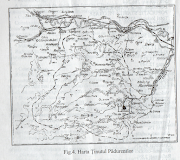As we have said in the previous articles, there are so many aspects about traditional outfits from Padurenime. Today we will explain in detail what women wear. First of all, we can say that the women's shirt/dress is one of the most complicated outfits from Romania. It has a lot of stitches with "arnica" to both the upper and the lower part of the costume.
The traditional dress is sewn on white material, woven in two threads, made of hemp or white cotton. The cut is made of straight shapes, rectangles or squares that are assembled together by creasing or sewing the parts together. The shirt consists of two parts: the bottom one- the skirt and the top part- the blouse.
Particularities of the women's traditional costume are the motifs. Let's see where we can find these motifs. They are found on the "collar", the "mouth of the feathered shirt", on the rows, on the two sleeves of the shirt as well as on the collars and "linings". They are usually red, green and blue. The motifs are sewn on the sleeves from the button to the top, in the form of rows similar to the column of infinity.
We would like to emphasise the upper part of the sleeve, which along and parallel to the "rows" has a stripe also decorated with sewn motifs called "alciță", "altita" and "p-altita". Respecting the principle of symmetry ,the bottom of the sleeve also has three parts, the "creases", the "sleeve collar" and the "feather liners".
Not to forget the bottom part, the skirt, which has similar motifs, also hand-made. Even if the they don't have the fineness of the seams from Muntenia or Banat for example, the motifs from our beautiful Tinutul Padurenilor are distinguished by the rigid and geometric design, with strong emphasis on design, colors and relief. These details have their own symbolism of the inhabitants of Tinutul Padurenilor because of their hard living and hard work on everything they do. The basic elements are nine in number "star", "pizar" "tri" "wheat" "pup" "four-eyed heli" "four-eyed heli and hooks" and "budina". The beautiful motifs are hand-made and keep the originality of this costume because of these basic, but so important elements.
The women folk costume from Tinutul Padurenilor is ankle-length(like a dress) with two parts sewn together, the top named "sheets-foi" and "shirt sheet-foaia cămeșii" and the bottom of it is called "hem-poale". Each part is individually hand-made being sewn together with the other parts at the end.
The bottom part of the traditional dress is divided in three parts. One of them is formed by 5 keys(cei) of vertical rows, parallel to the width of the seam varying between 4 and 10 cm, with various patterns (flowers, leaves) with black cotton(arnica). These should be on the two sides of the legs. A distance of 15-20 cm is left between them so they can be wricked, more precisely pleated. The lower part, next to the hem, is also sewn with black arnica or white silk with floral and geometric pattern, being horizontal, respectively perpendicular to the keys. The last part at the bottom is embroidery made of white cotton thread or lace with geometric patterns.
"Ciupegul" consists of sleeves, two front sheets and the back sheet as well as the collar with which the shirt closes at the neck..The sheet from the front of the "ciupeg" has also its symbolic motifs, sweden with red arnica or the same colors that the sleeves are made of. Also, on the sleeves, at the bottom, two more collars are used,one for each sleeve, to wrinkle the sleeve with "fodori"
The sleeves are cut , sewn the sleeve starting from the bottom, a seam about 40-50cm long on each sleeve. Note that the shirt is sewn with red arnica for girls and young women or black arnica for old women. The sleeve is formed by two parts, sewn together after each of them is hand crafted with different motifs and patterns.
As we finished with the description of the "shirt" we continue with the other elements of the traditional folk costume from Tinutul Padurenilor. The next two elements are very important too and it is essential to know how the women attach them to the entire outfit. The first one in order is called "opreg" and it is in the back, on top of the skirt. This item is made of wool and the color is obtained after dyeing with a solution made of alder bark. At the bottom and sides it is edged with threads and lace.
The front part is named the "quilt". It is made of black cloth adorned on the side and the bottom with straight apron which are brightly coloured, with red, green and blue predominating. The whole "cătrânța" (straight apron)" has lace on the ends.
 |
| Cătrânța (straight apron) Photo: Ioana Toplicean - Pure.madness.art |
The next element is called "brăcire" , a sort of belt with which the foresters are tied at the waist. Like the "opreg" it is woven at "war" from coloured woolen hair. Finally,the last element of this beautiful traditional outfit are the shoes. The forest woman first puts on her wool "colțuni" or " toloboni" and then she puts on her famous "opinci".
Ținutul Pădurenilor - România
Photo: Norana Adina, Andra Stefania , Ioana Toplicean

























0 Comments